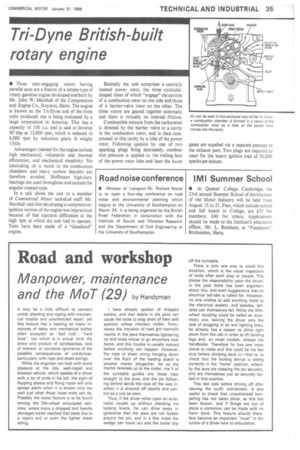Ti/-Dyne British-built rotary engine
Page 37

If you've noticed an error in this article please click here to report it so we can fix it.
• Three inter-engaging rotors having parallel axes are a feature of a simple type of rotary gasoline engine developed and built by Mr. John W. Marshall of the Compression and Engine Co., Royston, Herts. The engine is known as the Tr-Dyne and of the three units produced one is being evaluated by a large corporation in America. This has a capacity of 350 c.c. and is said to develop 90 bhp at 12,000 rpm, which is reduced to 6,000 rpm by reduction gears. It weighs 1351b.
Advantages claimed for the engine include high mechanical, volumetric and thermal efficiencies, and mechanical simplicity. No lubricating oil is burnt in the combustion chambers and heavy carbon deposits are therefore avoided. Hoffmann high-duty bearings are used throughout and include the angular-contact type.
In a talk about the unit to a member of Commercial Motor technical staff, Mr. Marshall said that developing a compressionignition version of the engine was impractical because of fuel injection difficulties at the high rpm at which the unit had to operate. Tests have been made of a "clieselized" engine. Basically the unit comprises a centrally located power rotor, the three cycloidalshaped lobes of which "engage" the cavities of a combustion rotor on one side and those of a barrier-valve rotor on the other. The three rotors are geared together externally and there is virtually no internal friction.
Combustible mixture from the carburetter is directed by the barrier valve to a cavity in the combustion rotor, and is then compressed in this cavity by a lobe of the power rotor. Following ignition by one of two sparking plugs firing alternately, combustion pressure is applied to the trailing face of the power rotor lobe and later the burnt
gases are expelled via a separate passage to the exhaust port. Two plugs are required to cater for the heavy ignition load of 36,000 sparks per minute,




































































































